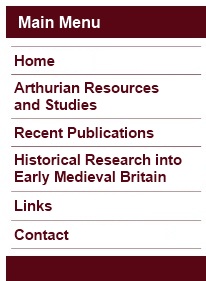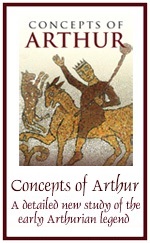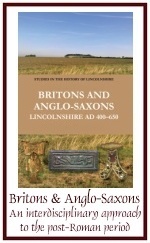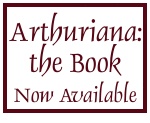 |
Reviews of Britons and Anglo-Saxons
Britons
and Anglo-Saxons was published on 18
September 2012
in both hardback and
paperback under a former nom de plume (336 pages, ISBNs 978-0-902668-24-9 and 978-0-902668-25-6).
It offers an interdisciplinary approach to the history of the Lincoln
region in the post-Roman period, drawing together a wide range of
sources. It is available in both paperback and hardback and hardback from Amazon and other
online bookstores, as well as direct from the publishers via their website.
from Amazon and other
online bookstores, as well as direct from the publishers via their website.
Review
of Britons and
Anglo-Saxons: Lincolnshire AD 400-650 (Lincoln, 2012), by
Nicholas Higham, Professor of Early Medieval and Landscape History,
University of
Manchester; published in Lincolnshire History & Archaeology, 47 (2012), pp. 99-100. It
was a pleasure to be asked to review this book. It is rare that one has
the opportunity to read a county-based study focused on the problems of
the British Dark Ages which is both so fully engaged with up-to-date
scholarship and operating assuredly across all relevant disciplines –
history, archaeology and place-name studies, plus occasionally
historical genetics and palaeoecology. Not only does it offer a
sophisticated study of Dark-Age Lincolnshire but it also makes an
important contribution to wider debates about the ending of Roman
Britain and the beginnings of Anglo-Saxon England.
Green uses
the introduction to contextualise his findings in terms of current
thought on the fifth and sixth centuries, highlighting possible
approaches, difficulties of the evidence and the main issues. The first
chapter then examines the later fourth century, stressing the
comparative vitality of Lincoln as a provincial capital and the
continuing use of villas and fortified centres around the capital. As
we move past 400, so the problem of archaeological invisibility becomes
a major issue, but away from the Fens, where inundation clearly had a
major impact, the author favours broadly stable population levels
across the period.
Chapter 2 then focuses on the emergence of a sub-Roman, British territory centred on Lincoln, from which it took the name *Lindēs, ultimately preserved in the name of the Anglo-Saxon kingdom, Lindisfaran (‘the people who migrated to the territory of *Lindēs’), and in the ninth-century Historia Brittonum as Linnuis.
On the periphery of the territory, large cremation cemeteries were
established, reflecting Anglian settlement. British control explains
the absence of early English burial around Lincoln. The distribution of
the new cemeteries is compatible with both Roman-period centres and the
wapentake system of the Anglo-Scandinavian period, suggesting
considerable administrative continuity, albeit with some sub-division.
The complex sequence of churches and cemeteries evidenced at St Paul in
the Bail in central Lincoln from the fourth to the sixth centuries
reflects its role as a place of power and influence. A concentration of
British penannular brooches and late Celtic hanging bowls recall a
British elite.
In chapter 3 the focus shifts to
Anglian-British interaction. While the early cemeteries may reflect the
presence of federates, literary evidence implies clashes. Mapping
Anglian cemeteries against the Romano-British provincial geography
implies that Lincoln retained a degree of control over the entire
province of Britannia Secunda. Y Gododdin, the early Welsh poem concerning the deaths of many warriors at Catraeth (probably Catterick, though that is hardly in the Vale of York (p. 95)), may refer to ‘men of Linnuis’
as participants. British names occur in a sixth-century context in the
genealogy of the kings of Lindsey and several Old English place-names
incorporate British personal names. While the second church of St Paul
in the Bail does not seem to have survived to 600, use of the cemetery
continued, and numerous local dedications to St. Helen also perhaps
reflect religious continuity. The replacement of British leadership of
the area by Anglo-Saxon therefore seems to have involved a degree of
accommodation. Green proposes a period of bilingualism followed by the
dominance of Old English, suggesting that Old Welsh would still have
been spoken in the region into the eighth century. There is material
evidence reflecting the crossover from British to Anglo-Saxon culture,
including pottery and metalwork.
The fourth chapter discusses the extent of *Lindēs,
arguing for an original ‘greater’ Lindsey which included much of
Kesteven, Holland and Hatfield. Attention focuses on Lissingleys – the
point of meeting of the three Ridings of the Viking Age. Three
cemeteries close by and a wide variety of earlier finds suggest a
meeting place, perhaps a Romano-Celtic temple or shrine, so a long
history of assembling in this vicinity. Elsewhere, some of the
prehistoric and Roman-period causeways across the Witham valley
continued in use, with attendant votive offerings. The debt of later
Anglo-Saxon Lindsey to *Lindēs is arguably considerable.
In
chapter 5 Green turns to the sub-divisions of Anglo-Saxon Lindsey. He
sees the Middle Angles as a significant kingdom in the long-term (which
I must admit I do not), seeing such as the Spaldingas as a sub-group within this major people. Within the Lindisfaran discussion focuses on the Billingas,
a group defined by cemeteries around Quarrington. Garwick, he suggests,
was a local wīc through which the large numbers of amber beads and
ivory artefacts found in the cemeteries had arrived. This in turn
encouraged the Mercians to take control of the area in the later
seventh century when they had lost London to the West Saxons, evidenced
by the exceptional c. 160 sceattas so far found at Garwick.
Chapter 6 assesses the probability that the Lindisfaran
colonised other areas, particularly Bernicia, where Lindisfarne
replicates the name, but also Deira in East Yorkshire, where the great
cremation cemetery of Sancton has close parallels with those in
Lindsey, and Repton in Derbyshire. If some memory of these fifth- and
sixth- century colonists survived into the seventh century, then this
may help explain the bitter contest between Northumbria and Mercia for
control of Lindsey.
The conclusion pulls together these
several strands, proposing that Anglo-Saxon Lindsey owed a considerable
debt to the forms and structures of Romano-British society there, via
the period of British rule in the fifth and early sixth centuries. On
this showing, some British elites as well as numerous peasants
successfully acculturated, though that process was largely later than
650.
This inter-disciplinary exploration of *Lindēs
offers a new standard for regional work. It also provides a model
capable of explaining how Roman Britain transmuted into Anglo-Saxon
England, emphasising continuities in local and regional structures as
well as population, alongside significant immigration. What it does not
do, though, is explain why this occurred. If British polities retained
control of Anglo-Saxon incomers right into the sixth century, how and
why was this balance reversed? And how does this equate with the Gallic
Chronicle of 452, which has power shifting to the Saxons in 441, and to
Gildas’ testimony, which describes Saxon rebellion and ravaging in what
has to be the fifth century? For my money the process was less peaceful
than Green would have us believe, but even so it is a convincing
analysis. But is Lincoln and its hinterland a special case, or is the
evidence merely more accessible here? Does it reflect what was
happening elsewhere across Britain, or not? These and many other
questions remain to be answered, but this book makes an important
contribution to the central historical debates and will provide an
important point of reference as to how we model the British/Anglo-Saxon
interface for the next generation.
* * * * *
Copyright
© 2013, 2014 Caitlin R. Green. All
Rights Reserved. To cite articles or pages from this website, use a
service such as WebCite
or alternatively see one of the following style citation guides. Comments and queries via email to Caitlin R. Green.
|
   |





